中国服饰文化 中英版
- 格式:ppt
- 大小:5.07 MB
- 文档页数:53
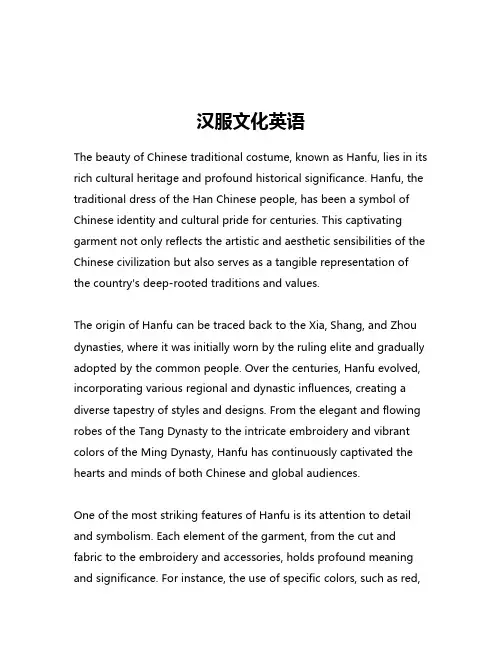
汉服文化英语The beauty of Chinese traditional costume, known as Hanfu, lies in its rich cultural heritage and profound historical significance. Hanfu, the traditional dress of the Han Chinese people, has been a symbol of Chinese identity and cultural pride for centuries. This captivating garment not only reflects the artistic and aesthetic sensibilities of the Chinese civilization but also serves as a tangible representation of the country's deep-rooted traditions and values.The origin of Hanfu can be traced back to the Xia, Shang, and Zhou dynasties, where it was initially worn by the ruling elite and gradually adopted by the common people. Over the centuries, Hanfu evolved, incorporating various regional and dynastic influences, creating a diverse tapestry of styles and designs. From the elegant and flowing robes of the Tang Dynasty to the intricate embroidery and vibrant colors of the Ming Dynasty, Hanfu has continuously captivated the hearts and minds of both Chinese and global audiences.One of the most striking features of Hanfu is its attention to detail and symbolism. Each element of the garment, from the cut and fabric to the embroidery and accessories, holds profound meaning and significance. For instance, the use of specific colors, such as red,yellow, and blue, often represented the wearer's social status, political affiliation, or personal aspirations. The intricate designs and patterns woven into the fabric were not merely decorative but also carried deep-rooted cultural and philosophical meanings, often reflecting the harmony between nature and humanity.Moreover, the donning of Hanfu was not just a matter of fashion but an integral part of the Chinese cultural and social fabric. The rituals and etiquette associated with wearing Hanfu were deeply embedded in the country's traditions, reflecting the respect for hierarchy, propriety, and the harmonious balance between the individual and the collective. The act of dressing in Hanfu was seen as a means of honoring one's ancestors, upholding cultural values, and maintaining a sense of identity and belonging.In recent years, the resurgence of interest in Hanfu has been a testament to the enduring appeal and relevance of this cultural treasure. Young people, in particular, have been at the forefront of this movement, rediscovering the beauty and significance of Hanfu and incorporating it into their daily lives. This renewed enthusiasm has not only sparked a revival of traditional craftsmanship and artistry but also fostered a deeper appreciation for the rich tapestry of Chinese history and culture.As the world becomes increasingly globalized, the preservation andpromotion of Hanfu have become even more crucial. The unique and captivating nature of this traditional Chinese costume has the power to bridge cultural divides, promote cross-cultural understanding, and inspire a deeper appreciation for the diversity of human civilization. By embracing and sharing the beauty and significance of Hanfu, we can contribute to the preservation of this invaluable cultural heritage and ensure that it continues to captivate and inspire generations to come.In conclusion, the Hanfu culture is a testament to the enduring spirit and artistic genius of the Chinese people. From its humble beginnings to its current resurgence, Hanfu has remained a powerful symbol of Chinese identity, a living embodiment of the country's rich history, and a testament to the enduring power of cultural expression. As we continue to explore and celebrate the beauty and significance of Hanfu, we can gain a deeper understanding of the universal human experience and the shared values that unite us all.。
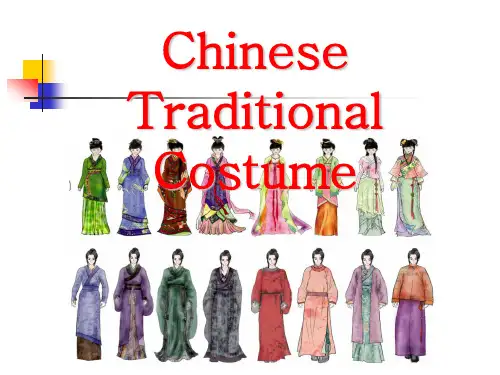

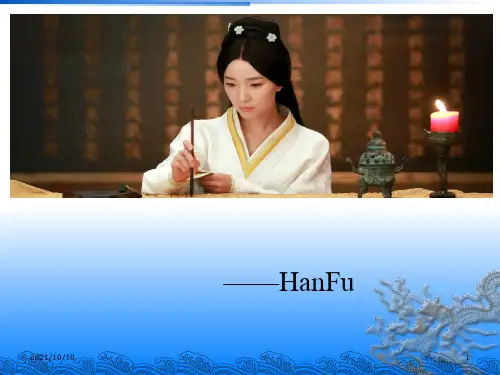
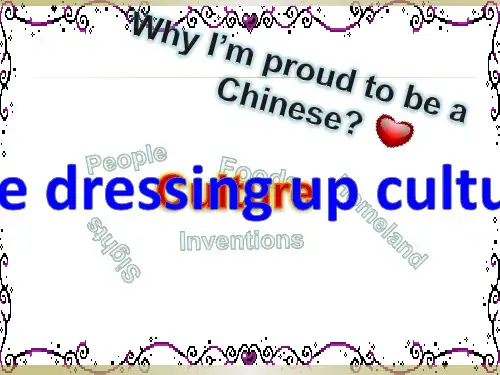
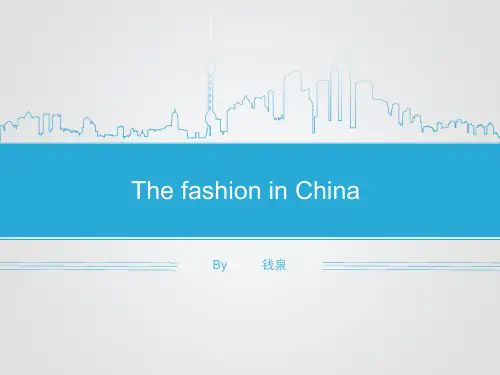

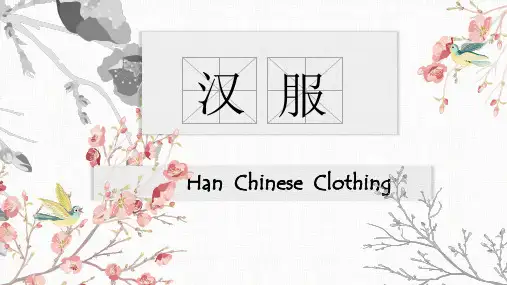
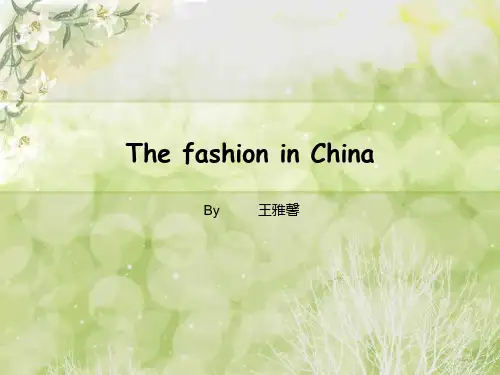
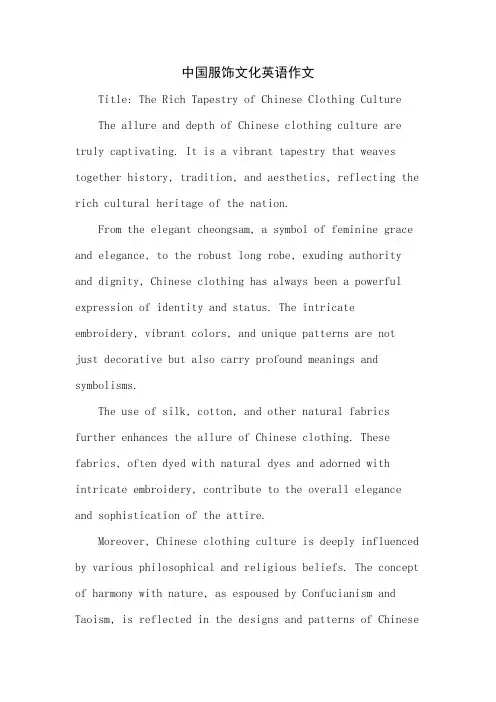
中国服饰文化英语作文Title: The Rich Tapestry of Chinese Clothing CultureThe allure and depth of Chinese clothing culture are truly captivating. It is a vibrant tapestry that weaves together history, tradition, and aesthetics, reflecting the rich cultural heritage of the nation.From the elegant cheongsam, a symbol of feminine grace and elegance, to the robust long robe, exuding authority and dignity, Chinese clothing has always been a powerful expression of identity and status. The intricate embroidery, vibrant colors, and unique patterns are notjust decorative but also carry profound meanings and symbolisms.The use of silk, cotton, and other natural fabrics further enhances the allure of Chinese clothing. These fabrics, often dyed with natural dyes and adorned with intricate embroidery, contribute to the overall elegance and sophistication of the attire.Moreover, Chinese clothing culture is deeply influenced by various philosophical and religious beliefs. The concept of harmony with nature, as espoused by Confucianism and Taoism, is reflected in the designs and patterns of Chineseclothing. Similarly, the use of auspicious symbols and motifs, such as the dragon and phoenix, are indicative of the influence of traditional beliefs and superstitions.In conclusion, Chinese clothing culture is not just a means of dressing but a powerful representation of the nation's rich history, traditions, and aesthetics. It is a tapestry that continues to evolve and adapt, while preserving its essence and charm, making it a captivating aspect of Chinese culture.。

了解中国服饰文化英语作文范文模板Exploring the Rich Tapestry of Chinese Clothing Culture: An English Essay TemplateChinese clothing culture is a kaleidoscope of tradition, symbolism, and evolution, reflecting the diverse history and values of this ancient civilization. From the majestic Hanfu of dynasties past to the contemporary fusion of East and West in modern fashion, China's sartorial heritage is a treasure trove waiting to be unveiled. This essay template seeks to unravel the intricacies of Chinese clothing culture, offering a glimpse into its vibrant colors, intricate designs, and profound significance.Introduction:- Begin with a captivating anecdote or historical fact that highlights the allure of Chinese clothing culture.- Introduce the significance of clothing in Chinese society and its role as a medium of expression and identity.Body Paragraphs:1. Historical Evolution:- Trace the evolution of Chinese clothing from ancient times to the present day, highlighting key dynasties and influential periods.- Explore the distinctive characteristics of each era's attire, from the flowing robes of the Han dynasty to the opulent qipao of the early 20th century.- Discuss the influence of social, political, and cultural factors on the development of Chinese clothing styles over time.2. Symbolism and Significance:- Examine the symbolic meanings embedded in traditional Chinese attire, such as the use of color, fabric, and motifs to convey social status, marital status, andcultural identity.- Explore the role of clothing in traditional ceremonies and rituals, such as weddings, funerals, and festivals, and its significance in preserving cultural heritage.- Discuss how traditional Chinese clothing continues to inspire contemporary fashion designers and enthusiasts around the world.3. Regional Diversity:- Highlight the regional diversity of Chinese clothing styles, showcasing the unique characteristics of garments from different provinces and ethnic groups.- Explore how environmental factors, economic activities, and cultural exchanges have shaped regional dress codes and traditions.- Discuss the importance of preserving and promoting regional clothing cultures in the face of globalization and modernization.Conclusion:- Summarize the rich tapestry of Chinese clothing culture, emphasizing its historical significance, symbolic meanings, and regional diversity.- Reflect on the enduring legacy of traditional Chineseattire and its continued relevance in contemporary society. - Encourage further exploration and appreciation of Chinese clothing culture as a means of fostering cross-cultural understanding and appreciation.In conclusion, Chinese clothing culture is a testament to the enduring legacy of this ancient civilization, weaving together threads of tradition, symbolism, and innovation. From the elaborate costumes of imperial courts to the everyday attire of modern urbanites, Chinese clothing reflects the rich tapestry of history, culture, and identity. By delving into the nuances of Chinese clothing culture, we not only gain a deeper understanding of the past but also forge connections that transcend borders and generations. So let us continue to explore, celebrate, and preserve this invaluable heritage for generations to come.。
中国传统服饰文化的英语作文The Splendor of Chinese Traditional Clothing CultureDeep within the rich tapestry of Chinese culture lies the allure of its traditional clothing, a vibrant mosaic that reflects the country's vast history, diverse ethnicities, and profound philosophical beliefs. This clothing culture, dating back thousands of years, is not just a means of covering the body, but a powerful medium of artistic expression and cultural identity.The earliest recorded Chinese clothing was simple and functional, made from natural fibers like silk and cotton. Over time, these garments evolved to incorporate intricate patterns, vibrant colors, and elaborate embroidery, reflecting the sophistication of Chinese craftsmanship and aesthetic sensibilities. The use of symbols and motifs in clothing designs further embodied the cultural values and beliefs of the people.One of the most iconic features of Chinese traditional clothing is the use of the “qipao,”a tight-fitting, one-piece dress that accentuates the female form. Originally worn by the Manchu ethnic group, the qipao has become a symbol of elegance and femininity, not only in China but also in manyparts of the world. Its sleek lines and intricate designs make it a timeless piece that can be worn for both formal and casual occasions.Men's traditional clothing, on the other hand, is often associated with the “changshan,”a long robe that flows gracefully with the wearer's movements. This garment, often made of silk or brocade, exudes an air of dignity and sophistication, befitting the image of a scholar or gentleman.The colors and patterns used in Chinese traditional clothing also hold deep cultural significance. For instance, red is often associated with luck, prosperity, and happiness, making it a popular choice for weddings and other festive occasions. The use of dragon and phoenix motifs represents imperial power and marital harmony, respectively.Moreover, Chinese traditional clothing is not just about aesthetics; it is also a reflection of the country's philosophical beliefs. The harmonious blend of colors, patterns, and cuts embodies the Confucian ideal of harmony and balance. The emphasis on natural fibers and dyes reflects a deep respect for nature and a commitment to sustainability.中国传统服饰文化的辉煌在中国文化的丰富织锦中,传统服饰的魅力深藏其中,这是一幅充满生机的马赛克画,反映了中国悠久的历史、多样的民族和深刻的哲学信仰。
中国服饰文化英语高考作文Chinese costume culture is an integral part of the nation's profound and extensive cultural heritage, representing a unique aesthetic and philosophical perspective that has evolved over thousands of years.Chinese: 中国服饰文化是中华民族深厚悠久文化遗产的重要组成部分,体现了几千年来形成的独特审美和哲学观念。
Paragraph 1:In ancient China, costumes served not only as clothing but also as a symbol of social status and hierarchy. The 'Ru Yi', 'Shang Yi', 'Zi Yi', and 'Shi Yi' represented the four main classes during the Zhou Dynasty – the robes denoted the rank and role of the wearer, from nobility to peasants. For instance, the dragon robe was exclusively reserved for the emperor, reflecting supreme authority and power. This concept is echoed in English as "costumes were more than mere attire; they were emblematic of one's position within society".Chinese: 古代中国的服饰不仅是遮体之物,更是社会地位与等级的象征。